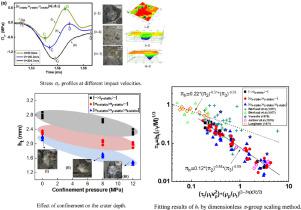International Journal of Mechanical Sciences ( IF 7.3 ) Pub Date : 2021-08-06 , DOI: 10.1016/j.ijmecsci.2021.106714 Lei Zhang 1 , Junfang Shan 1 , Chunhe Miao 1 , Chengnian Fan 1 , Pengfei Wang 1 , Songlin Xu 1, 2

|
It is of great significance to evaluate the cratering performances of concrete target subjected to steel projectile impacting. Different from the method proposed by Forrestal et al. (2003) to record the acceleration signals in steel projectile by single-channel acceleration data recorder, a new testing equipment is established in the present study to record the dynamic triaxial responses of concrete target by six lateral bars. The projectile impacts the target through a hollow square bar (one of six lateral bars), and the true triaxial confinements are applied on the target through six lateral bars which loaded by three servo-controlled cylinders. These three forces, i.e. end resistance, lateral reaming resistance, and lateral traction, acted on the projectile toe during cratering process are discussed respectively by wave signal εy- recorded on the left bar in y-axial, by wave signals εx+, εx-, εz+, and εz- recorded on the lateral bars, and by specially assigned strain gauges demonstrated in Appendix B. Series of experiments of concrete targets under various impact velocities and under various confinements are conducted accordingly. Two stages, e.g. the accelerating cratering stage, and the decelerating cratering and penetration stage, are observed in stress σy- profiles. Similar lateral reaming stages are observed in stress profiles of lateral bars. These stress profiles could be used to evaluate forces applied on projectile toe, and lateral tractions could be ignored. Comparing with the cratering process in the impact direction, there are about 10µs delaying for the lateral reaming process. Depth of crater and pulse duration decrease with increasing confinements, and they exhibit obvious velocity and confinement dependency. Three dimensionless factors, i.e. the inertial effect, the strength effect, and the deformation characteristics, are introduced to evaluate the crater depth. Strength of concrete target is proven to be the most important factor in the cratering process for concrete target under lower impact velocity. This work provides comprehensive and profound understanding of the effects of multiaxial confinement on the crater resistance for concrete-like materials.
中文翻译:

真三轴约束下混凝土靶材的弹坑性能
评价混凝土靶在钢弹撞击下的弹坑性能具有重要意义。与 Forrestal 等人提出的方法不同。(2003) 用单通道加速度数据记录仪记录钢弹中的加速度信号,在本研究中建立了一种新的测试设备,用于记录六个横向钢筋对混凝土目标的动态三轴响应。射弹通过一个空心方棒(六个横向棒之一)撞击目标,真正的三轴约束通过六个横向棒施加在目标上,这些横向棒由三个伺服控制气缸加载。分别用波信号讨论了弹头在弹膛过程中作用在弹尖上的端阻力、侧向铰孔阻力和侧向牵引力这三种力。ε y-记录在 y 轴左侧杆上,通过波信号ε x+、ε x-、ε z+和ε z-记录在侧杆上,并通过附录 B 中演示的专门指定的应变计进行。 系列实验在不同的冲击速度和不同的限制下的具体目标相应地进行。在应力σ y-中观察到两个阶段,例如加速坑洼阶段和减速坑洞和渗透阶段个人资料。在横向钢筋的应力分布中观察到类似的横向铰孔阶段。这些应力分布可用于评估施加在弹头上的力,并且可以忽略横向牵引力。与冲击方向上的凹坑过程相比,横向铰孔过程有大约10μs的延迟。火山口深度和脉冲持续时间随着约束的增加而减小,并且它们表现出明显的速度和约束依赖性。引入惯性效应、强度效应和变形特性三个无量纲因素来评价陨石坑深度。混凝土靶材的强度被证明是在较低冲击速度下混凝土靶材开坑过程中最重要的因素。


























 京公网安备 11010802027423号
京公网安备 11010802027423号